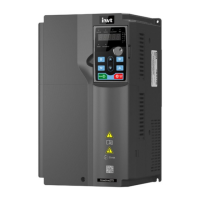Goodrive270 series VFD for fan and pump Communication protocol
-293-
9 Communication protocol
9.1 What this chapter contains
This chapter describes the communication of the VFD.
The VFD provides RS485 communication interfaces and adopts the master-slave communication
based on the international standard Modbus communication protocol. You can implement centralized
control (setting commands for controlling the VFD, modifying the running frequency and related
function code parameters, and monitoring the working state and fault information of the VFD) through
PC/PLC, upper control computer, or other devices to meet specific application requirements.
9.2 Modbus protocol introduction
Modbus is a communication protocol for use with electronic controllers. By using this protocol, a
controller can communicate with other devices through transmission lines. It is a general industrial
standard. With this standard, control devices produced by different manufacturers can be connected
to form an industrial network and be monitored in a centralized way.
The Modbus protocol provides two transmission modes, namely American Standard Code for
Information Interchange (ASCII) and remote terminal units (RTU). On one Modbus network, all the
device transmission modes, baud rates, data bits, check bits, stop bits, and other basic parameters
must be set consistently.
A Modbus network is a control network with one master and multiple slaves, that is, on one Modbus
network, there is only one device serving as the master, and other devices are the slaves. The master
can communicate with any single slave or with all slaves. For separate access commands, a slave
needs to return a response. For broadcasted information, slaves do not need to return responses.
9.3 Application of Modbus
The VFD uses the Modbus RTU mode and communicates through RS485 interfaces.
9.3.1 RS485
RS485 interfaces work in half-duplex mode and transmit data signals in the differential transmission
way, which is also referred to as balanced transmission. An RS485 interface uses a twisted pair,
where one wire is defined as A (+), and the other B (-). Generally, if the positive electrical level
between the transmission drives A and B ranges from +2V to +6V, the logic is "1"; and if it ranges from
-2V to -6V, the logic is "0".
The 485+ terminal on the terminal block of the VFD corresponds to A, and 485- corresponds to B.
The communication baud rate (P14.01) indicates the number of bits sent in a second, and the unit is
bit/s (bps). A higher baud rate indicates faster transmission and poorer anti-interference capability.
When a twisted pair of 0.56 mm (24 AWG) is used, the maximum transmission distance varies
according to the baud rate, as described in the following table.

